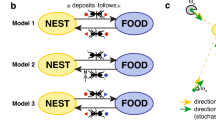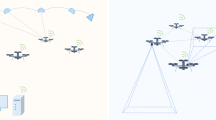Abstract
We consider the problem of coordinating a team of agents that have to collect disseminated resources in an unknown environment. We are interested in approaches in which agents collectively explore the environment and build paths between home and resources. The originality of our approach is to simultaneously build an artificial potential field (APF) around the agents’ home while foraging. We propose a multi-agent model defining a distributed and asynchronous version of Barraquand et al. Wavefront algorithm. Agents need only to mark and read integers locally on a grid, that is, their environment. We prove that the construction converges to the optimal APF. This allows the definition of a complete parameter-free foraging algorithm, called c-marking agents. The algorithm is evaluated by simulation, while varying the foraging settings. Then we compare our approach to a pheromone-based algorithm. Finally, we discuss requirements for implementation in robotics.












Similar content being viewed by others
Notes
Breadth First Search.
If several neighboring cells have the minimum value, \(c_\mathrm{min}\) is one of them.
RGB = agent ID (8 bit) + #iteration (modulo \(2^{16}\)) (16 bit).
Consider the marking of a 3-cell long trail in a \(2\times 2\) area (i.e., the trail is turning). If during the two last iterations, the not yet marked cell of the \(2\times 2\) area is updated, the trail could continue to this cell, then forming a \(2\times 2\) region. Such a region was observed only in simulations with a high density of agents (i.e., number of agents is greater than 25 % of the size environment).
To reach such a “dead end” is also necessary that the values of the area have changed since their coloring.
It requires that agents write both the date \(t_v\) and the relative quantity of pheromone \(q_v\) in visited cells, then when reading a cell \(q(t)=\rho ^{t-t_v}\cdot q_v\).
These algorithms are dedicated to real-time re-planning in dynamic and unknown environments.
References
Arkin, R. (1998). Behavior based robotics. Cambridge, MA: The MIT Press.
Barraquand, J., Langlois, B., & Latombe, J. (1991). Numerical potential field techniques for robot path planning. In ’Robots in Unstructured Environments’, 91 ICAR., Fith International Conference on Advanced robotics (pp. 1012–1017). Picataway, NJ: IEEE Press.
Barraquand, J., Langlois, B., & Latombe, J. (1992). Numerical potential field techniques for robot path planning. IEEE Transactions on Systems, Man and Cybernetics, 22(2), 224–241.
Bonabeau, E., Dorigo, M., & Theraulaz, G. (1999). Swarm intelligence: From natural to artificial systems. New York: Oxford University Press.
Deneubourg, J. L., Aron, S., Goss, S., Pasteels, J. M., & Duerinck, G. (1986). Random behaviour, amplification processes and number of participants : How they contribute to the foraging properties of ants. Physica D, 22(1–3), 176–186.
Drogoul, A., & Ferber, J. (1992). From Tom Thumb to the dockers: Some experiments with foraging robots. In 2nd Int. Conf. on simulation of adaptative behavior (pp. 451–459). Cambridge, MA: A Bradford Book / The MIT Press.
Ferber, J. (1999). Multi-agent systems, an introduction to distributed artificial intelligence. London: Addison-Wesley.
Garnier, S., Tache, F., Combe, M., Grimal, A., & Theraulaz, G. (2007). Alice in pheromone land: An experimental setup for the study of ant-like robots. In Swarm Intelligence Symposium, IEEE SIS 2007 (pp. 37–44). Piscataway, NJ: IEEE.
Glad, A., Simonin, O., Buffet, O., & Charpillet, F. (2008). Theoretical study of ant-based algorithms for multi-agent patrolling. In Proceedings ECAI’08 18th European Conference on Artificial Intelligence (pp. 626–630). Amsterdam: IOS Press.
Gutknecht, O., & Ferber, J. (2001). The MADKIT agent platform architecture. In Infrastructure for Agents, LNAI 1887 (pp. 48–55). Berlin: Springer.
Herianto, A., & Kurabayashi, D. , (2009). Realization of an artificial pheromone system in random data carriers using RFID tags for autonomous navigation. Proceedings ICRA’09 International Conference on Robotics and Automation (pp. 2288–2293). Piscataway, NJ: IEEE Press.
Hoff, N. R. I., Sagoff, A., Wood, R. J., & Nagpal., R., (2010). Two foraging algorithms for robot swarms using only local communication. In Proceedings of IEEE-ROBIO 2010: 2010 IEEE International Conference on Robotics and Biomimetics (pp. 123–130). Piscataway, NJ: IEEE Press.
Holldobler, B., & Wilson, E. (1990). The ants. Cambridge, MA: Harvard University Press.
Johansson, R., & Saffiotti, A. (2009). Navigating by stigmergy: A realization on an RFID floor for minimalistic robots. In Proc. of the IEEE Int. Conf. on Robotics and Automation (pp. 245–252). Picataway, NJ: IEEE Press.
Khatib, O. (1985). Real-time obstacle avoidance for manipulators and mobile robots. In Proceedings of IEEE Intern. Conf. on Robotics and Automation ICRA (pp. 500–505). Los Alamitos, CA: The IEEE Computer Society Press.
Koenig, S., & Likhachev, M. (2005). Fast replanning for navigation in unknown terrain. IEEE Transactions on Robotics, 21(3), 354–363.
Kowadlo, G., & Russell, R. A. (2008). Robot odor localization: A taxonomy and survey. The International Journal of Robotic Research, 27(8), 869–894.
López-Ibañez, M., Dubois-Lacoste, J., Stützle, T., & Birattari, M. (2011). The iRace Package: Iterated Racing for Automatic Algorithm Configuration. Technical report, IRIDIA Technical Report Series No. 2011–004, Université Libre de Bruxelles.
Mamei, M., & Zambonelli, F. (2005). Spreading pheromones in everyday environments through RFID technology. In In Proc. of the 2d IEEE Symposium on Swarm Intelligence, pages 281–288. IEEE Computational Intelligence Society, New York.
Michel, F., Beurier, G., & Ferber, J. (2005). The turtlekit simulation platform: application to complex systems. Workshops Sessions, First International Conference on Signal-Image Technology and Internet-based Systems (pp. 122–127). Los Alamitos, CA: IEEE.
Monekosso, N., Remagnino, P., & Szarowicz, A. (2002). An improved Q-learning algorithm using synthetic pheromones. In From theory to practice in multi-agent systems, second international workshop of central and eastern europe on multi-agent systems, CEEMAS 2001 Cracow. Revised Papers, Lecture Notes in Artificial Intelligence LNAI-2296 (pp. 197–206). Berlin: Springer.
Norris, J. R. (1998). Markov Chains (Cambridge Series in Statistical and Probabilistic Mathematics No. 2). Cambridge University Press, UK.
Panait, L., & Luke, S. (2004). A pheromone-based utility model for collaborative foraging. In Proc AAMAS’04 Third International Joint Conference on Autonomous Agents and MultiAgent Systems (pp. 36–43). New York: ACM Press.
Parunak, H. V. D. (1997). Go to the ant: Engineering principles from natural agent systems. Annals of Operations Research, 75, 69–101.
Parunak, H. V. D., Purcell, M., & O’Connell, R. (2002). Digital pheromones for autonomous coordination of swarming UAV’s. In Proc. of AIAA First Technical Conference and Workshop on Unmanned Aerospace Vehicles, Systems, and Operations. American Institute of Aeronautics and Astronautics.
Pepin, N., Simonin, O., & Charpillet, F. (2009). Intelligent tiles: Putting situated multi-agents models in real world. In Proceedings ICAART’09 International Conference on Agents and Artificial Intelligence (pp. 513–519). Setúbal, Portugal: INSTICC Press.
Purnamadjaja, A. H., & Russell, R. A. (2010). Bi-directional pheromone communication between robots. Robotica, 28(1), 69–79.
Resnick, M. (1994). Turtles, termites, and traffic jams: Explorations in massively parallel microworlds. Cambridge, MA: MIT Press.
Sauter, J. A., Matthews, R., Parunak, H. V. D., & Brueckner, S. (2002). Evolving adaptive pheromone path planning mechanisms. In Proc. of AAMAS’02 First International Joint Conference on Autonomous Agents and Multi-Agent Systems (pp. 434–440). New York: ACM Press.
Sauter, J. A., Matthews, R., Parunak, H. V. D., & Brueckner, S. (2005). Performance of digital pheromones for swarming vehicle control. In Proc. of AAMAS’05 Fouth International Joint Conference on Autonomous Agents and MultiAgent Systems (pp. 903–910). New York: ACM Press.
Sempe, F., & Drogoul, A. (2003). Adaptive patrol for a group of robots. In IEEE/RSJ International Conference on Intelligent Robots and Systems (IROS 2003) (pp. 2865–2869). Piscataway, NJ: IEEE Press.
Spears, W., Spears, D., Hamann, J., & Heil, R. (2004). Distributed, physics-based control of swarms of vehicles. Autonomous Robots, 17(2–3), 137–162.
Steels, L. (1989). Cooperation between distributed agents through self-organization. In Decentralized AI- Proc. of the First European Workshop on Modelling Autonomous Agents in a Multi-Agent World (MAAMAW-89) (pp. 175–196). Amsterdam: Elsevier Science.
Stentz, A. (1995). The focussed D* algorithm for real-time replanning. In Proc. of the International Joint Conference on Artificial Intelligence (IJCAI) (pp. 1652–1659). San Francisco, CA: Morgan Kaufmann.
Vaughan, R. T., Støy, K., Sukhatme, G. S., & Matarić, M. J. (2000). Whistling in the dark: cooperative trail following in uncertain localization space. In Proc. of the 4th International Conference on Autonomous Agents (Agents’00) (pp. 187–194). New York: ACM Press.
Wagner, I., Lindenbaum, M., & Bruckstein, A. M. (1998). Efficiently searching a graph by a smell-oriented vertex process. Annals of Mathematics and Artificial Intelligence, 24, 211–223.
Wagner, I., Lindenbaum, M., & Bruckstein, A. M. (2000). MAC vs. PC: Determinism and randomness as complementary approaches to robotic exploration of continuous unknown domains. International Journal of robotics Research, 19(1), 12–31.
Winfield, A. (2009). Towards an engineering science of robot foraging. In Distributed Autonomous Robotic Systems 8, Proceedings of the 9th International Symposium on Distributed Autonomous Robotic Systems (DARS 2008) (pp. 185–192). Berlin: Springer.
Zhu, Q., Yan, Y., & Xing, Z. (2006). Robot path planning based on artificial potential field approach with simulated annealing. In Proceedings ISDA’06 Sixth International Conference on Intelligent Systems Design and Applications (Vol. 2, pp. 622–627). Los Alamitos, CA: IEEE Computer Society Press.
Acknowledgments
The authors wish to thank the editors and referees for their work in order to improve the analysis and the presentation of the results. We would also like to thank Olivier Buffet and Bruno Scherrer for their help in writing the paper, Anna Crowley and Julien Ponge for the English proofreading.
Author information
Authors and Affiliations
Corresponding author
Electronic supplementary material
Below is the link to the electronic supplementary material.
Supplementary material 1 (mpg 3344 KB)
Supplementary material 2 (mpg 442 KB)
Rights and permissions
About this article
Cite this article
Simonin, O., Charpillet, F. & Thierry, E. Revisiting wavefront construction with collective agents: an approach to foraging. Swarm Intell 8, 113–138 (2014). https://doi.org/10.1007/s11721-014-0093-3
Received:
Accepted:
Published:
Issue Date:
DOI: https://doi.org/10.1007/s11721-014-0093-3




